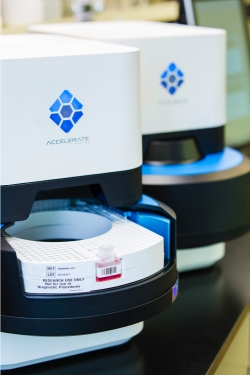Military Infectious Diseases Research Program (JPC-2)
Rapid Diagnostics for Multidrug Resistant Organisms in Combat-Related Infection



Posted April 29, 2016
Connie Price, M.D., Denver Health and Hospital Authority
 The occurrence of multidrug resistant infection is a major concern in Wounded Warriors and military Veterans, especially in combat-related injuries. In addition to Methicillin-resistant Staphylococcus aureus (MRSA), other resistant strains have been associated with hospital-acquired infections that are often not responsive to even a broad range of antibiotics. Culture-directed antibiotic treatment is an early treatment regime for these kinds of infections. However, one of the key challenges of using this treatment regime is that laboratory culture analysis, which is central to antibiotic selection, requires at least two days to produce results. The delay in targeted treatment results in greater patient distress, poorer outcomes, higher overall cost, and dilution of antibiotic effectiveness as bacteria continue to adapt.
The occurrence of multidrug resistant infection is a major concern in Wounded Warriors and military Veterans, especially in combat-related injuries. In addition to Methicillin-resistant Staphylococcus aureus (MRSA), other resistant strains have been associated with hospital-acquired infections that are often not responsive to even a broad range of antibiotics. Culture-directed antibiotic treatment is an early treatment regime for these kinds of infections. However, one of the key challenges of using this treatment regime is that laboratory culture analysis, which is central to antibiotic selection, requires at least two days to produce results. The delay in targeted treatment results in greater patient distress, poorer outcomes, higher overall cost, and dilution of antibiotic effectiveness as bacteria continue to adapt.
With funding from a Fiscal Year 2012 Military Infectious Diseases Applied Research Award, Dr. Connie Price and her team at Denver Health are aiming to identify rapid microbiological diagnostics for multidrug resistant organism (MDRO) pathogens that afflict Wounded Warriors and Veterans and, furthermore, would help clinicians more effectively treat patients with serious infections. Dr. Price's approach involves the use of multiplexed automated digital microscopy (MADM), which has the ability to identify and quantify multiple pathogens within 2 hours. In preclinical research, Dr. Price and her team have demonstrated that MADM (Figure 1) is able to characterize multiple major modes of antibiotic resistance, including MRSA, within 6 hours. Furthermore, Dr. Price has used MADM to characterize heterogeneous and inducible resistance and has also performed population analysis profiles of S. aureus.
Dr. Price has acquired remnant blood, respiratory, and infected wound samples and identified the causative pathogen and, most importantly, determined its susceptibility to multiple antibiotics, often 1-2 days faster than conventional lab methods. Since the start of the funding period, Dr. Price and her team have validated and identified (within 1 hour) target bacterial species including S. aureus, Escherichia coli, Klebsiella pneumoniae, Klebsiella oxytoca, Enterobacter aerogenes, Enterobacter cloacae, Acinetobacter baumanii, and Pseudomonas aeruginosa with sensitivity and specificity of at least 97% in blood cultures. Furthermore, she has performed antibiotic susceptibility testing with specific minimum inhibitory concentration within 5 hours for methicillin versus S. aureus, ciprofloxacin, imipenem, amikacin and minocycline versus A. baumanii, and ciprofloxacin and amikacin versus P. aeruginosa.
Dr. Price and her team are actively collaborating with an industry partner, Accelerate Diagnostics, Inc., to develop a novel pathogen identification and antibiotic susceptibility tests directly from study of clinical samples. The data gathered in this effort has facilitated Accelerate Diagnostics to obtain consensus from the U.S. Food and Drug Administration and clearance for the first test that will rapidly identify and determine antibiotic susceptibility of pathogens causing bloodstream infections. Additional information about Dr. Price's research can be found in the Journal of Microbiological Methods (2014; 98:50-58).

Figure 1: Automated Digital Microscope - Microbes are extracted from a specimen. The extracts are imaged over time using the Automated Digital Microscope to monitor growth under a variety of conditions. The images are processed and microbe identity and antimicrobial susceptibility profiles are reported.
Publication:
Price CS, Kon SE, Metzger S. 2014. Rapid antibiotic susceptibility phenotypic characterization of Staphylococcus aureus using automated microscopy of small numbers of cells. J Microbiol Methods 98:50-58. PMID: 24393790.
Links:
Last updated Friday, March 7, 2025














